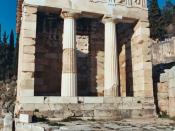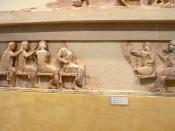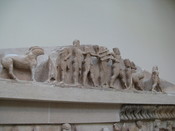The Siphnian Treasury was built at Delphi by the people of Siphnos, sometime before 525 BC, after a lucky strike of silver on their island. The porch is supported by Caryatids (figures of women), and there are friezes on all sides. This is the earliest known instance of a continuous narrative frieze. The Siphnian Treasury is one of the most securely dated monuments of the Archaic period. This makes it extremely important, since the date of so much else is pinned on it. The friezes on the West and South sides however have significant portions missing, making identification of their meanings difficult to decipher.
The sculptural decoration of the Siphnian Treasury exhibits two rather distinct styles. This is probably because of a division of work between two sculptors and their workshops. This hypothesis seems to be confirmed in an inscription on the north frieze, where one of the artists takes responsibility for the sculptures on the north and the east sides.
The carving on these sides are bold and varied in depth. The West and South sides differ because unlike the varied depth of carving on the north and east, two planes are emphasized: the foreplane of the figures and the background of the relief.
"The friezes show: the war of the gods and Giants; the Judgement of Paris; the gods and a duel at Troy; a procession. The east pediment shows the struggle between Apollo and Herakles for the Delphic tripod. The quality of the carving makes this an important monument for the dating of Archaic Greek sculpture." 1
East Frieze of the Siphnian Treasury at Delphi
"The right half of the frieze (below) shows a duel at Troy, with Trojans to the left and Greeks to the right looking on. The left half of the frieze (above) shows...


